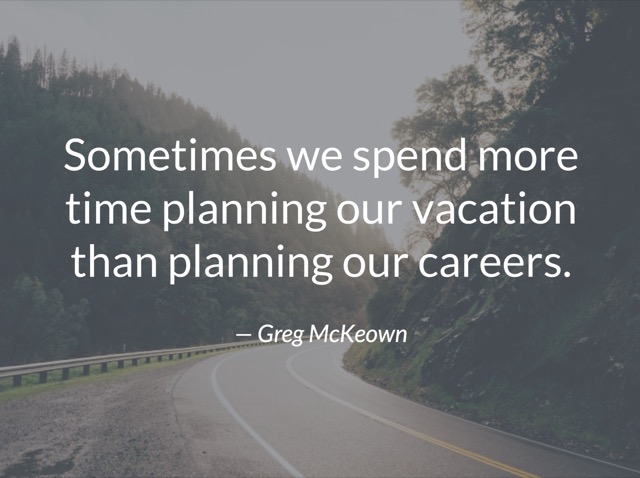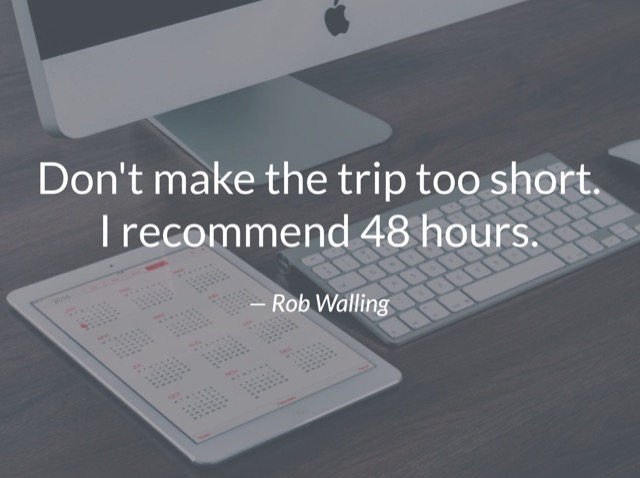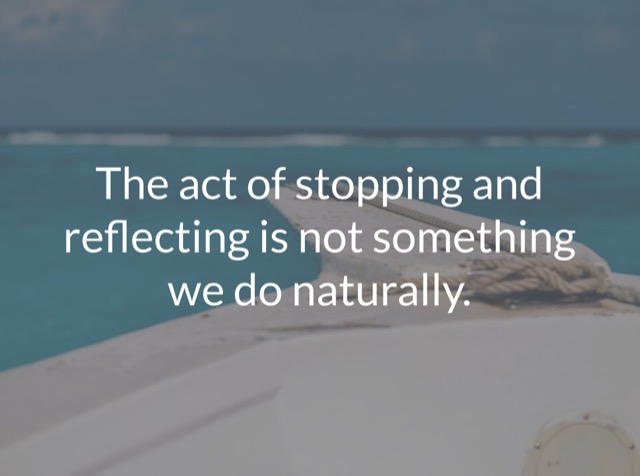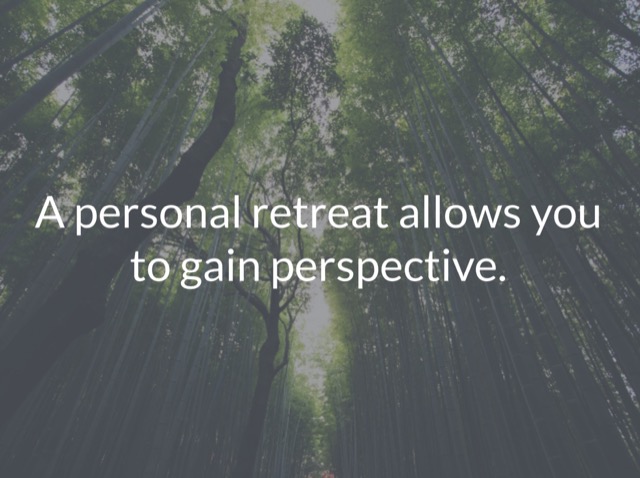
Prefer to listen instead of reading? Gaining Traction is a weekly podcast that delivers this blog’s content in an audio format. Subscribe via iTunes, Stitcher, or RSS.
I’m pretty confident of this:
Taking regular personal retreats is one of the best habits you can develop to ensure the health of your business.
Now, you may be thinking, “I don’t have the time for a personal retreat”, “I have kids”, or “I have a day job I can’t just take time away from.”
These are valid reasons, but every one of them can be overcome. Once you see how beneficial a personal retreat is to your business and personal life, you will wonder how you ever functioned without them.
In this post, we’ll be looking at what exactly is a personal retreat, what people do on a personal retreat, and how can you fit one in when you have other commitments that make it difficult to take time away in solitude.
I Don’t Need a Personal Retreat, I’m Doing Just Fine
Why do we even need a personal retreat?
I used to think this way. I’d hear people take personal retreats and I’d say “must be nice”. I can’t do that, I’ve got four young kids!
Well, there are a handful of benefits that an entrepreneur experiences when taking a personal retreat:
- A personal retreat allows you to gain perspective. Perspective helps move your business forward. Whereas meditation helps you to gain perspective during your day, a personal retreat provides prospective for the next few months and beyond.
- A personal retreat is a discipline. The act of stopping and reflecting is not something we do naturally, especially entrepreneurs. We are often so excited to move a project forward that the act of pausing takes conscious effort. A personal retreat forces us to stop, unplug, and make decisions that will greatly impact the future of our businesses.
- A personal retreat prevents stagnation. A good personal retreat will inspire you to set a few goals for the next few months. This forces us into a time-crunch to complete certain activities, moving the business forward.
Taking a personal retreat is not easy, it does require some scheduling and perhaps even a little money if an overnight is involved. However, the time and money spent are more than recouped if your retreat helps you to take your business to the next level.
It’s amazing how little time we spend in reflection on our businesses. Author of the book Essentialism Greg McKeown writes:
“Sometimes we spend more time planning our vacation than planning our careers.”
Greg McKeown
When we go on vacation, not only do we often create a list to ensure that we don’t forget anything, but we get our affairs in order as well.
We stop the mail, we arrange for someone to keep an eye on the house, we mark our calendars, and we clear our schedules. If we can do it for our vacations, we can certainly do it for a personal retreat.

So How Long is this Personal Retreat Supposed to Be?
Depending on who you talk to, a personal retreat can last anywhere from a single workday to a whole week. Many people find two days to be ideal.
Rob Walling, founder of Drip recently did an “Ask Me Anything” thread on Bootstrappers.io, and had this to say about his retreats:
“[The ideal length is] 48 hours or longer (totally solo, no family, no kids). This also means you need to feel like you have plenty of time to make this successful. So don’t make the trip too short. I recommend 48 hours.”
Rob Walling
In contrast, Greg McKeown calls his reflection time “Quarterly Offsites”, and does them every three months, for a part of the workday.
Depending on the level of decision-making, prioritizing, and de-stressing you need to do, the length and frequency of a retreat will vary.

Me, I have four young children and a wife that works part-time. Getting away for several days is a big ask from my wife, so I have elected to go on the 1-day quarterly personal retreat schedule.
I like the quarterly retreat because it forces me to set three-month goals, which is usually a long enough time to finish something meaningful, but short enough that I don’t procrastinate. I might even break down my quarterly goal into monthly achievable, which I then visit when making my weekly plan every Sunday night.
What Is the Agenda of a Personal Retreat?
The last thing you want to do is go on a personal retreat and waste time not getting deep into the things that need to be thought through.
It helps to have an agenda going into the retreat so you know what to reflect upon.
Part 1: Reflection
I always kick my retreats off by reflecting on the time since the last retreat:
- What have I accomplished since my last retreat?
- What has worked well for me since my last retreat?
- How do I feel about what I’ve accomplished since my last retreat?
- What am I thankful for since my last retreat?
- What could I have done differently since my last retreat?
Part 2: Stillness
I think this step is critical. If you haven’t meditated before, check out my earlier post on meditation for entrepreneurs. After clearing out your thoughts from the period since your last retreat, try to spend some time just being aware of your thoughts.
Enjoy a break from all of the distractions of your daily life. Your email, Twitter, your children interrupting you.
Just…relax.
Another great activity during this time is to take a walk. If you are out in nature, head out on a trail. Get moving so your brain can enjoy the increase of oxygen, and who knows what thoughts might enter your mind.
If you are a person of faith, this could be a great time to spend in prayer. Ask for clarity and wisdom as you move into the planning period.

Part 3: Planning
By now you should be ready to sit down and start planning out the next period between retreats. Here are a few questions that might be helpful to explore during this time:
- What would make this next period awesome?
- Where do I see myself in the next 2 years?
- How can this next period help me achieve those long-term goals?
- What events are coming up that I need to prepare for?
- How can I break my goals up into monthly blocks?
- What will I get started on in the next week?
- What could potentially prevent me from achieving these goals?
Hopefully, by the end of reflecting upon these questions, you will have a pretty good idea of what you’ll be trying to accomplish over the next few months until your next retreat.
Are There Any Ideal Locations for a Retreat?
While there are dedicated retreat centers located throughout the country, you can have an effective retreat often within an hour’s drive or so from where you currently live.
Even in a big city, there are Metroparks and quiet libraries for hiking and journaling. Perhaps a little noise helps you to reflect, so a downtown coffee shop might be a good spot for an afternoon.
If you’re taking a multi-day retreat, look for cabin rentals or rooms near a lake, ocean, forest, desert, mountains, or river.
To Unplug or Not?
This is a tough one:
Should you bring your laptop to a personal retreat?
Some people like to go in with just a notebook and a few pens. Some people bring their full technology stack with them.
I like having my laptop with me to dump my goals into my task management software. However, during my reflection time, it is just me and a notebook.
It is during this “unplugged” time that I gain most of my insight. Arianna Huffington (co-founder of the Huffington Post) states:
Your performance will actually improve if you can commit to not only working hard, but also unplugging, recharging and renewing yourself.
Arianna Huffington
If having your laptop will become a distraction that prevents you from really getting away, then I would suggest not bringing it. If you can limit its use to only that which benefits your implementation of insight gained during the retreat, then go ahead and bring it.
My Last Retreat’s Itinerary
The last time I took a personal retreat, I utilized a 1-day schedule and told my wife I’d be coming home late for dinner. I started the day off earlier than normal to maximize the potential of the day.
6:00 – Headed to Starbucks for a wake-me-up and to start journaling on the previous three months.
8:00 – Headed to the Metropark for some hiking and time to let my thoughts organize themselves from the morning’s reflection time.
10:30 – Headed to a French bakery I love for a fresh croissant. This is one of those pleasures I don’t enjoy very often, so I wanted to have something to look forward to mid-morning.
11:00 – Got in my car and drove to the conservatory. This retreat was during the wintertime, so I wanted to feel rejuvenated by entering the lush, humid rainforest room. It was here that I took a seat and spent some time in deep thought and stillness.
12:30 – Enjoyed lunch and reading.
1:30 – Headed to the lobby at the Hilton (plenty of tables and chairs, fireplace). Did my future planning and goal setting.
4:00 – Headed to another Metropark for a final hike to let any final thoughts go through processing and settle in.
5:30 – Stopped into the local library to whip out my laptop and put my final reflections into my task management software. I also put my goals on the calendar as a reminder.
6:30 – Feeling rejuvenated and inspired by the plans for the next three months, I headed home.

Conclusion
Taking time away for a personal retreat is a discipline that not many professionals take seriously enough. We have enough going on in our daily lives that a break “just to think” sounds pretty unproductive. However, it is during those breaks in our routine that we discover whether or not what we are being productive in is what matters.
We can utilize this time to ensure that our ships are on the right course and that we are not missing any major opportunities that are right in front of us.
Taking time out to think is perhaps one of the best uses of our time as entrepreneurs.